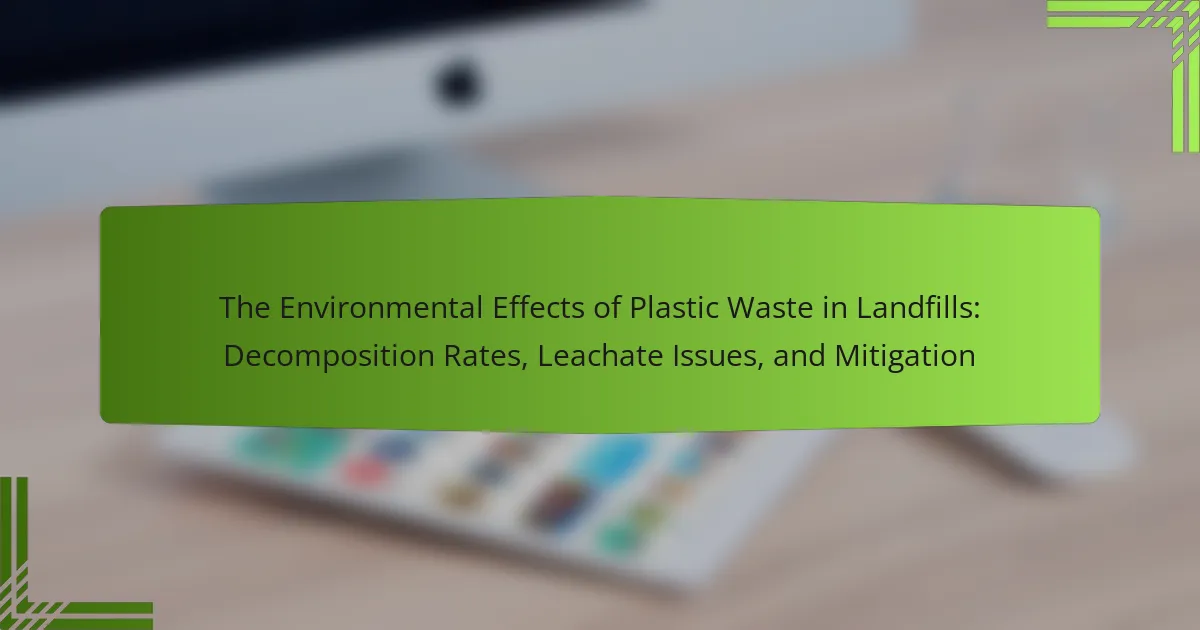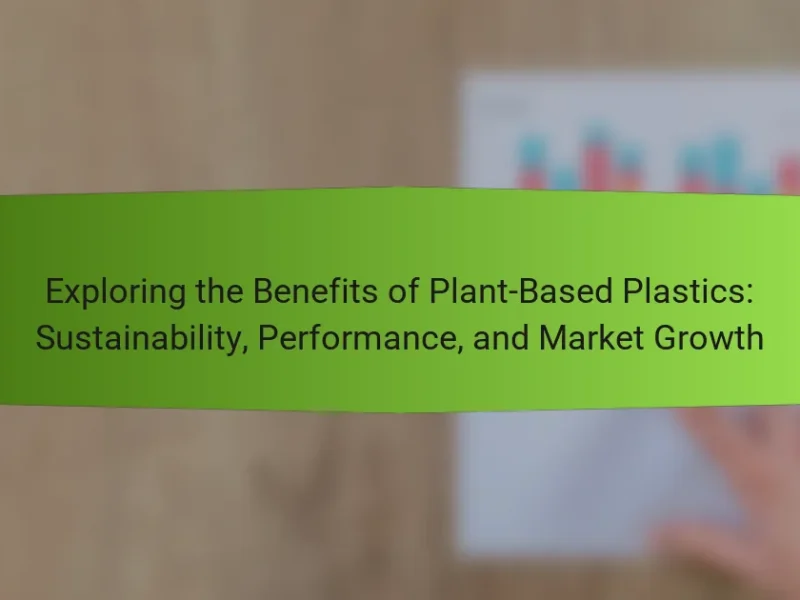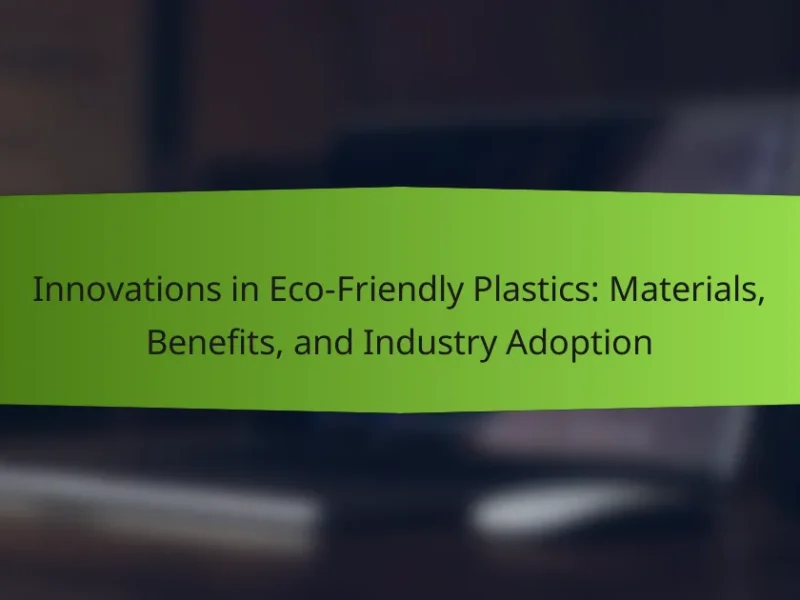Plastic waste in landfills poses significant environmental challenges due to its slow decomposition rates, which can span hundreds to thousands of years. During this prolonged period, plastics break down into microplastics, contaminating soil and waterways and posing risks to wildlife and human health. The leachate produced from decomposing plastics can release toxic chemicals, further polluting groundwater sources and impacting ecosystems. Effective mitigation strategies, including increased recycling, the promotion of biodegradable alternatives, improved waste management practices, and public education, are essential to address the environmental effects of plastic waste in landfills.
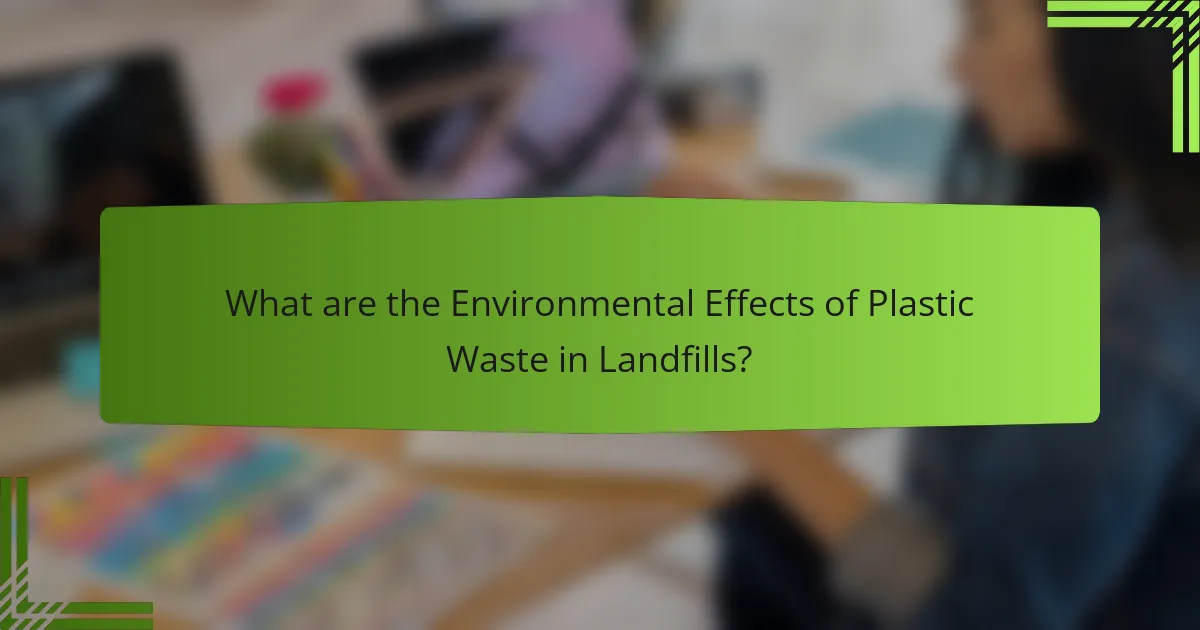
What are the Environmental Effects of Plastic Waste in Landfills?
Plastic waste in landfills has significant environmental effects. It takes hundreds to thousands of years to decompose. During this time, plastics can break down into microplastics. These microplastics contaminate soil and waterways. They pose risks to wildlife and human health. Leachate from decomposing plastics can release toxic chemicals. These chemicals can pollute groundwater sources. According to the Environmental Protection Agency, landfills are a major source of plastic pollution. This pollution affects ecosystems and biodiversity.
How does plastic waste impact soil quality in landfills?
Plastic waste significantly impacts soil quality in landfills by altering its physical and chemical properties. The presence of plastic can lead to reduced soil aeration and drainage. This degradation of soil structure can hinder plant growth and microbial activity. Additionally, plastics can leach harmful chemicals into the soil. These chemicals can contaminate soil and groundwater, posing risks to ecosystems and human health. Research shows that plastics can take hundreds of years to decompose, exacerbating these issues. The accumulation of plastic waste disrupts nutrient cycling in the soil. Consequently, soil fertility declines, affecting agricultural productivity.
What are the chemical changes that occur in soil due to plastic waste?
Plastic waste causes significant chemical changes in soil. It alters the soil’s pH levels, often increasing acidity. This change affects nutrient availability for plants. Plastic waste can also introduce toxic substances like heavy metals into the soil. These contaminants can leach into groundwater, posing risks to ecosystems. Additionally, the decomposition of plastics releases harmful chemicals like phthalates and bisphenol A (BPA). These compounds disrupt soil microbial activity and biodiversity. The presence of plastic waste can lead to reduced soil fertility over time. Studies indicate that soil contaminated with plastics shows altered chemical properties compared to uncontaminated soil.
How does plastic waste affect soil organisms?
Plastic waste negatively affects soil organisms by disrupting their habitat and function. Soil organisms, such as bacteria, fungi, and invertebrates, are essential for nutrient cycling and soil health. The presence of plastic can lead to physical barriers that hinder movement and access to resources. Additionally, plastic can leach harmful chemicals into the soil, altering the microbial community structure. Studies indicate that microplastics can reduce the diversity of soil microbial communities, impacting their ecological roles. Research has shown that the accumulation of plastic waste can decrease soil fertility and disrupt ecosystem services. These changes can ultimately impair plant growth and soil resilience.
What are the implications of plastic waste on groundwater quality?
Plastic waste significantly impacts groundwater quality. It contributes to leachate formation, which contains harmful chemicals. These chemicals can seep into the groundwater, leading to contamination. Research shows that leachate from landfills often includes heavy metals and organic pollutants. A study by the United Nations Environment Programme found that plastic waste can release toxic substances over time. These substances can affect aquatic ecosystems and human health. Additionally, once groundwater is contaminated, it is challenging and costly to remediate. Therefore, managing plastic waste is crucial to protect groundwater resources.
What is leachate and how does it form in landfills?
Leachate is a liquid that forms when water percolates through waste materials in landfills. This liquid contains various dissolved organic and inorganic substances. Leachate forms primarily due to precipitation and moisture in the landfill. As rainwater seeps through the waste, it dissolves contaminants and collects them. The composition of leachate varies depending on the types of waste present. It can include heavy metals, nutrients, and pathogens. Proper management of leachate is crucial to prevent environmental contamination. Landfills often have liners and collection systems to manage leachate effectively.
What contaminants are commonly found in leachate from plastic waste?
Leachate from plastic waste commonly contains heavy metals, organic compounds, and microplastics. Heavy metals such as lead, cadmium, and mercury can leach into groundwater. Organic compounds include phthalates and bisphenol A, which are toxic to aquatic life. Microplastics can also be present, contributing to environmental pollution. Studies have shown that leachate can have high concentrations of these contaminants, posing risks to ecosystems and human health. For example, research indicates that leachate from landfills can exceed safety limits for these substances, highlighting the need for effective waste management practices.
How does plastic waste contribute to greenhouse gas emissions?
Plastic waste contributes to greenhouse gas emissions primarily through its decomposition in landfills. When plastic waste breaks down, it can release methane, a potent greenhouse gas. Methane has a global warming potential over 25 times that of carbon dioxide over a 100-year period. In 2018, landfills in the United States emitted approximately 114 million metric tons of carbon dioxide equivalent, largely due to organic waste decomposition. Additionally, the production and incineration of plastics also generate greenhouse gases. The entire lifecycle of plastic, from production to disposal, significantly impacts climate change.
What gases are emitted during the decomposition of plastic waste?
During the decomposition of plastic waste, several gases are emitted. These gases include methane, carbon dioxide, and volatile organic compounds. Methane is produced primarily under anaerobic conditions. Carbon dioxide is released during both aerobic and anaerobic decomposition processes. Volatile organic compounds can also be emitted as plastics break down. The presence of these gases contributes to greenhouse gas emissions. Methane is particularly potent, with a global warming potential significantly higher than carbon dioxide. Studies indicate that the decomposition of plastics can lead to substantial gas emissions over time.
How do these emissions affect climate change?
Emissions from plastic waste in landfills significantly contribute to climate change. These emissions primarily include methane and carbon dioxide, both potent greenhouse gases. Methane is produced during the anaerobic decomposition of organic materials in landfills. It has a global warming potential 25 times greater than carbon dioxide over a 100-year period.
In 2018, landfills in the United States emitted approximately 114 million metric tons of carbon dioxide equivalent, according to the Environmental Protection Agency. This substantial emission contributes to the greenhouse effect, trapping heat in the atmosphere. The increase in these gases leads to rising global temperatures, causing climate-related impacts such as extreme weather events and sea-level rise.
Additionally, the production and incineration of plastic waste further exacerbate emissions, adding to the overall carbon footprint. Thus, the emissions from plastic waste in landfills play a critical role in accelerating climate change.
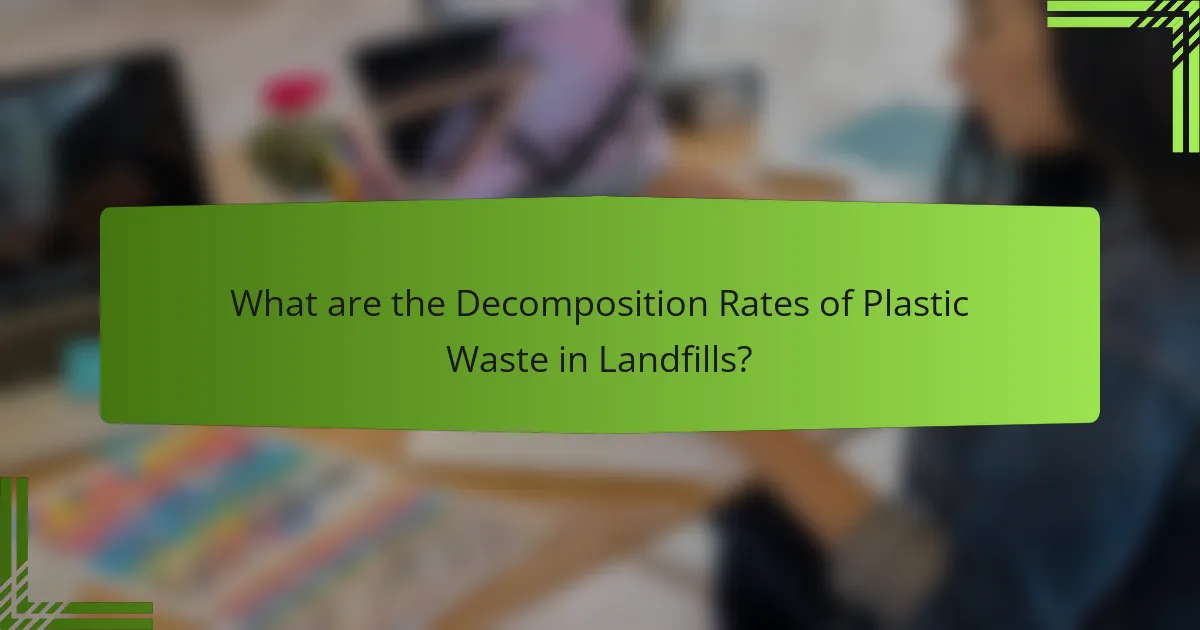
What are the Decomposition Rates of Plastic Waste in Landfills?
Plastic waste in landfills decomposes very slowly. Estimates suggest that plastic can take hundreds to thousands of years to decompose. Factors such as type of plastic and landfill conditions affect these rates. For instance, polyethylene can take up to 1,000 years to break down. In contrast, polystyrene may persist for over 500 years. Limited exposure to sunlight and oxygen in landfills slows decomposition. Microbial activity is also reduced, further extending breakdown times. Research indicates that most plastics do not fully decompose, leading to long-term environmental concerns.
How long does it take for different types of plastics to decompose?
Different types of plastics take varying amounts of time to decompose. For example, plastic bags can take up to 10 to 20 years to decompose. PET bottles typically require around 450 years for decomposition. Styrofoam can last indefinitely, as it is resistant to breakdown. Other plastics, like food containers, may decompose in 50 to 80 years. These times vary based on environmental conditions. Factors such as sunlight, temperature, and microbial activity influence decomposition rates. Research indicates that most plastics break down into microplastics rather than fully decomposing. This highlights the long-lasting impact of plastic waste in landfills.
What factors influence the decomposition rates of plastic materials?
The decomposition rates of plastic materials are influenced by several factors. These include the type of plastic, environmental conditions, and the presence of microorganisms. Different plastics have varying chemical structures, affecting their breakdown speed. For instance, biodegradable plastics decompose faster than traditional plastics. Environmental conditions such as temperature, moisture, and sunlight exposure significantly impact decomposition rates. Higher temperatures and moisture levels typically accelerate the breakdown process. Additionally, the presence of microorganisms can enhance decomposition, as certain bacteria and fungi can break down plastic materials. Studies have shown that plastics in marine environments decompose more slowly due to lower temperatures and lack of microbial activity.
How do environmental conditions affect plastic decomposition?
Environmental conditions significantly affect plastic decomposition rates. Factors such as temperature, moisture, and sunlight play crucial roles. Higher temperatures generally accelerate the breakdown of plastics. Moisture levels influence microbial activity, which can enhance decomposition. Sunlight exposure, particularly UV radiation, can cause photodegradation, leading to fragmentation.
Research shows that plastics can take hundreds of years to decompose in landfills due to anaerobic conditions. In contrast, plastics exposed to natural elements can degrade more quickly. For instance, studies indicate that polyethylene can degrade in as little as 1 to 3 years under optimal environmental conditions.
Therefore, the interaction between these environmental factors directly impacts the efficiency of plastic decomposition in various settings.
What are the challenges in measuring decomposition rates of plastics?
Measuring decomposition rates of plastics faces several challenges. One major challenge is the variability in environmental conditions. Factors such as temperature, moisture, and microbial activity significantly influence decomposition rates. Another challenge is the diversity of plastic types. Different plastics have varied chemical compositions, affecting their breakdown processes.
Additionally, the time frame for measuring decomposition is often long. Some plastics can take hundreds of years to decompose, making short-term studies ineffective. The presence of additives in plastics complicates measurements as they can alter degradation rates.
Moreover, standardizing measurement methods is difficult. Different studies may use varying techniques, leading to inconsistent results. Lastly, the lack of comprehensive data on long-term decomposition hinders accurate assessments. These factors collectively make it challenging to measure the decomposition rates of plastics effectively.
What methodologies are used to study plastic decomposition in landfills?
Common methodologies used to study plastic decomposition in landfills include laboratory experiments, field studies, and modeling approaches. Laboratory experiments often simulate landfill conditions to assess plastic degradation rates. These experiments utilize controlled environments to monitor variables like temperature, moisture, and microbial activity. Field studies involve collecting samples from landfills to analyze real-world decomposition processes. Researchers often measure physical and chemical changes in plastics over time. Modeling approaches use computational simulations to predict decomposition rates based on various environmental factors. These methodologies provide insights into how plastics break down in landfill settings.
Why is it difficult to obtain accurate data on plastic decomposition rates?
Obtaining accurate data on plastic decomposition rates is difficult due to several factors. The variability in plastic types affects decomposition rates. Different plastics have distinct chemical compositions and structures. Environmental conditions also play a significant role. Factors such as temperature, moisture, and microbial activity influence degradation.
Additionally, the time frame for decomposition can span decades to centuries. This long duration complicates observational studies. Limited research funding restricts comprehensive studies on plastic degradation. Many existing studies focus on short-term effects rather than long-term decomposition.
Finally, the lack of standardized methodologies leads to inconsistent results. Different research approaches can yield varying conclusions. These challenges collectively hinder the acquisition of precise data on plastic decomposition rates.
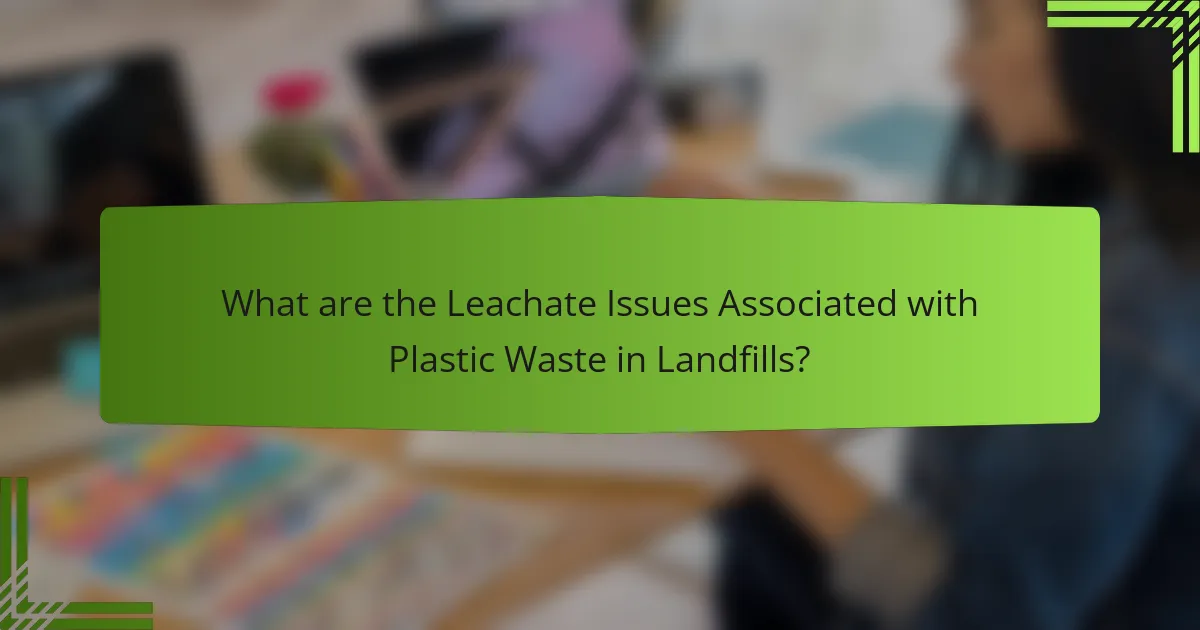
What are the Leachate Issues Associated with Plastic Waste in Landfills?
Leachate issues associated with plastic waste in landfills include the contamination of groundwater and soil. Plastics can take hundreds of years to decompose. During this time, they can release harmful chemicals into leachate. This leachate can contain toxic substances like heavy metals and organic pollutants. These contaminants pose significant risks to ecosystems and human health. Studies show that leachate from landfills can exceed safe levels of pollutants. For example, a study published in the Journal of Environmental Management found elevated concentrations of heavy metals in leachate from plastic waste. Proper management of plastic waste is crucial to mitigate these leachate issues.
What are the environmental risks posed by leachate from plastic waste?
Leachate from plastic waste poses significant environmental risks. It can contaminate soil and groundwater with harmful chemicals. These chemicals include heavy metals, organic pollutants, and toxins. Contaminated water sources can affect drinking water quality. Leachate can also harm aquatic ecosystems when it enters rivers and lakes. This leads to biodiversity loss and disrupts food chains. The presence of leachate can increase the cost of water treatment. Effective management of leachate is crucial to mitigate these risks.
How does leachate migration occur in landfill sites?
Leachate migration occurs when contaminated liquid from decomposing waste moves through soil and groundwater. This process begins as rainwater filters through landfill materials, dissolving organic and inorganic substances. The resulting leachate can contain harmful pollutants, including heavy metals and organic compounds. As leachate builds up, it exerts pressure, pushing it through the landfill liner or surrounding soil. Factors such as soil permeability, landfill design, and the presence of fractures influence migration rates. Studies indicate that leachate can travel significant distances, potentially impacting nearby water sources. For example, research shows that leachate can migrate over 1,000 feet from a landfill site under certain conditions.
What are the potential impacts of leachate on nearby ecosystems?
Leachate can significantly harm nearby ecosystems. It often contains toxic substances, including heavy metals, organic compounds, and nutrients. These contaminants can leach into soil and groundwater, affecting plant and animal life. Elevated nutrient levels from leachate can lead to eutrophication in nearby water bodies. This process causes excessive algal blooms, which deplete oxygen and harm aquatic organisms. Heavy metals can accumulate in the food chain, posing risks to wildlife and humans. Studies have shown that leachate can reduce biodiversity in affected areas. Research indicates that leachate impacts can persist long after the source is removed.
What are the regulatory standards for leachate management?
Regulatory standards for leachate management are established to protect environmental and public health. The Resource Conservation and Recovery Act (RCRA) governs hazardous waste management in the U.S. It includes specific regulations for leachate treatment and disposal. The Clean Water Act (CWA) also applies, regulating discharges into water bodies. States may have additional regulations that further define leachate management practices. For example, many states require leachate collection systems in landfills. These systems must be designed to prevent leachate from contaminating groundwater. Monitoring and reporting of leachate quality is often mandated. Compliance with these standards is essential for landfill operators.
What guidelines exist for monitoring leachate in landfills?
Guidelines for monitoring leachate in landfills include regular sampling and analysis of leachate quality. The United States Environmental Protection Agency (EPA) recommends monitoring parameters such as pH, conductivity, and concentrations of contaminants. Monitoring should occur at established points within the landfill, typically at leachate collection systems. Frequency of monitoring can vary but is often conducted quarterly or biannually. Documentation of findings is crucial for compliance with regulations. The EPA also advises implementing a leachate management plan to address treatment and disposal. These guidelines help ensure potential environmental impacts are minimized.
How do regulations vary by region regarding leachate treatment?
Regulations regarding leachate treatment vary significantly by region. In the United States, the Environmental Protection Agency (EPA) sets federal standards, but states can impose stricter regulations. For example, California has regulations that require advanced treatment methods for leachate. In Europe, the European Union enforces the Landfill Directive, mandating leachate management plans. Countries like Germany have stringent requirements for leachate treatment, focusing on recycling and reuse. In contrast, some developing regions may lack comprehensive regulations, leading to less effective treatment. These differences impact the effectiveness of leachate management and environmental protection efforts across regions.
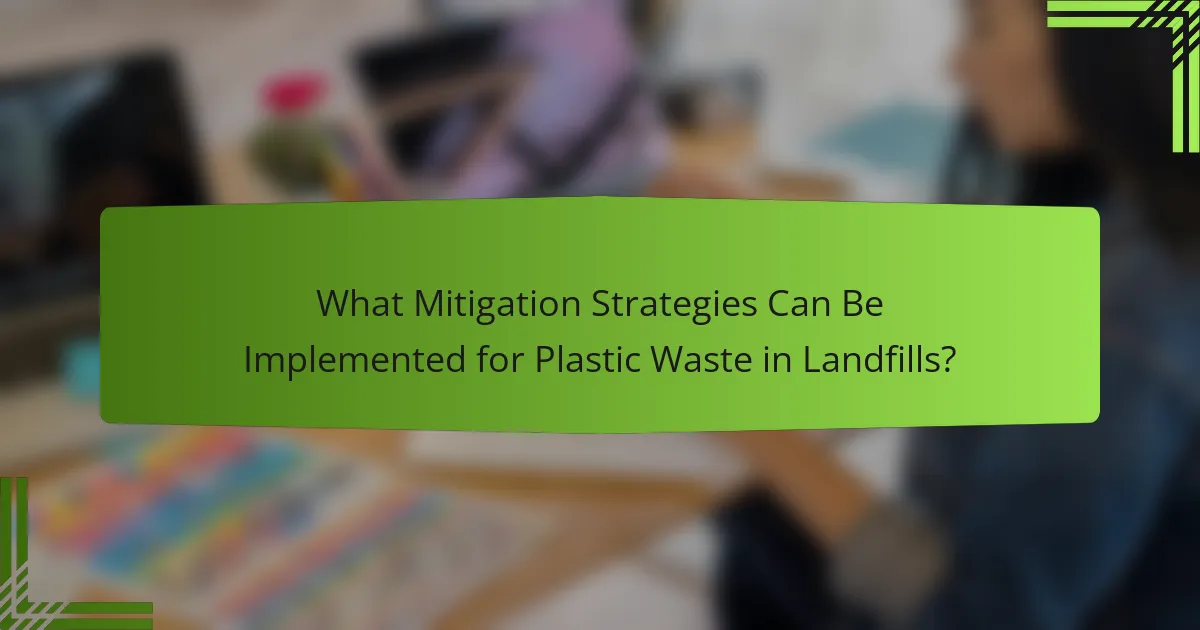
What Mitigation Strategies Can Be Implemented for Plastic Waste in Landfills?
Implementing effective mitigation strategies for plastic waste in landfills involves several key approaches. First, increasing recycling rates can significantly reduce the amount of plastic entering landfills. According to the Environmental Protection Agency, recycling can divert approximately 30% of plastic waste. Second, promoting biodegradable alternatives to traditional plastics can minimize long-term environmental impact. Studies show that biodegradable plastics can decompose within months under the right conditions. Third, enhancing waste management practices, including better sorting and collection systems, ensures more efficient processing of plastics. Research indicates that improved waste management can lead to a 50% reduction in landfill plastic waste. Lastly, public education campaigns can raise awareness about plastic pollution and encourage responsible consumption. Data from the World Economic Forum highlights that informed consumers are more likely to engage in sustainable practices. These strategies collectively contribute to reducing plastic waste in landfills and mitigating its environmental effects.
What are the best practices for reducing plastic waste in landfills?
Implementing recycling programs is essential for reducing plastic waste in landfills. These programs encourage the separation of recyclable materials from general waste. Public education on proper disposal methods increases participation in recycling efforts. Additionally, promoting the use of biodegradable alternatives can significantly lower plastic usage. Encouraging businesses to adopt sustainable packaging practices also contributes to waste reduction. Establishing community clean-up initiatives helps to collect plastic waste from the environment. Governments can enforce stricter regulations on plastic production and disposal. These combined efforts can effectively minimize plastic waste in landfills.
How can recycling initiatives help mitigate plastic waste?
Recycling initiatives can significantly reduce plastic waste by converting used plastics into new products. This process decreases the demand for virgin plastic production. According to the Environmental Protection Agency, recycling and composting prevented the release of 186 million metric tons of carbon dioxide equivalent into the air in 2013. Recycling also conserves energy, as it typically uses less energy than creating new plastics from raw materials. For instance, recycling one ton of plastic can save up to 1,000 to 2,000 gallons of gasoline. Additionally, effective recycling programs can divert plastics from landfills, where they can take hundreds of years to decompose. Implementing community recycling initiatives increases public awareness and participation, further enhancing plastic waste reduction efforts. Overall, recycling initiatives play a crucial role in mitigating the environmental impact of plastic waste.
What role does public awareness play in reducing plastic waste?
Public awareness plays a crucial role in reducing plastic waste. Increased awareness leads to more informed consumer choices. Educated individuals are more likely to reduce, reuse, and recycle plastics. Campaigns highlighting the environmental impact of plastic waste have proven effective. For instance, studies show that communities with strong awareness initiatives reduce plastic usage by up to 30%. Awareness also encourages policy changes and corporate responsibility. As people demand sustainable practices, businesses adapt to meet these expectations. Overall, public awareness is essential for fostering a culture of sustainability and reducing plastic waste effectively.
How can landfill design be improved to manage plastic waste better?
Landfill design can be improved to manage plastic waste better by incorporating advanced containment systems. These systems can prevent leachate from contaminating groundwater. Utilizing impermeable liners reduces the risk of plastic breakdown products entering the environment. Implementing bioreactor landfills can accelerate the decomposition of organic waste, potentially reducing plastic waste volume. Regular monitoring of landfill conditions ensures early detection of issues. Educating the public on proper waste disposal can decrease plastic waste entering landfills. Research indicates that improved landfill design can lead to a 50% reduction in leachate generation. Enhanced recycling facilities adjacent to landfills can also divert plastics from disposal.
What technologies are available for leachate treatment?
Technologies available for leachate treatment include biological treatment, chemical treatment, and physical treatment. Biological treatment utilizes microorganisms to break down organic matter in leachate. This method effectively reduces biochemical oxygen demand (BOD) and total suspended solids (TSS). Chemical treatment involves the addition of chemicals to leachate to remove contaminants. Common chemicals used are chlorine, ozone, and ferric chloride. Physical treatment methods include membrane filtration, adsorption, and evaporation. Membrane filtration separates contaminants from leachate using semi-permeable membranes. Adsorption utilizes materials like activated carbon to capture pollutants. Evaporation reduces leachate volume by converting it to vapor. These technologies are essential for minimizing environmental impacts from landfill leachate.
How can landfill liners and caps minimize environmental impacts?
Landfill liners and caps minimize environmental impacts by preventing leachate from contaminating groundwater. Liners are made from impermeable materials that block liquids from escaping the landfill. This containment reduces the risk of harmful substances entering the soil and water supply. Caps cover the landfill surface, reducing rainwater infiltration. By limiting water exposure, caps decrease leachate production. According to the U.S. Environmental Protection Agency, proper landfill design can significantly lower the risk of environmental contamination. Effective liners and caps are essential for sustainable waste management practices.
What are practical steps individuals can take to reduce plastic waste?
Individuals can reduce plastic waste by adopting several practical steps. First, they can use reusable bags instead of single-use plastic bags. This change can significantly decrease the amount of plastic entering landfills. Second, individuals should opt for refillable water bottles rather than buying bottled water. Studies show that over 1 million plastic bottles are purchased every minute worldwide. Third, they can choose products with minimal or no plastic packaging. This choice encourages manufacturers to reduce plastic use. Fourth, recycling plastic items correctly is crucial. According to the Environmental Protection Agency, only about 9% of plastic is recycled in the U.S. Lastly, individuals can participate in local clean-up events to remove plastic waste from the environment. These actions collectively contribute to reducing plastic waste effectively.
How can consumers make more sustainable choices regarding plastic use?
Consumers can make more sustainable choices regarding plastic use by reducing, reusing, and recycling. Reducing involves minimizing the purchase of single-use plastics. This can significantly decrease the amount of plastic waste generated. Reusing includes opting for products that can be used multiple times, such as cloth bags and glass containers. This practice extends the life cycle of materials and reduces demand for new plastic production. Recycling helps divert plastic from landfills, where it can take hundreds of years to decompose. According to the Environmental Protection Agency, only about 9% of plastic waste is recycled in the U.S. Therefore, consumers should actively participate in recycling programs. Additionally, choosing products with minimal or no plastic packaging supports companies that prioritize sustainability. These actions collectively contribute to a reduction in plastic pollution and its environmental impact.
What community initiatives can support plastic waste reduction?
Community initiatives that support plastic waste reduction include local recycling programs, educational campaigns, and clean-up events. Local recycling programs enable residents to properly dispose of plastic materials. Educational campaigns raise awareness about the impact of plastic waste on the environment. Clean-up events encourage community members to actively participate in removing plastic waste from local areas. Studies show that communities with active recycling programs can reduce plastic waste by up to 30%. Engaging the community fosters a collective responsibility towards reducing plastic consumption.
The primary entity of this article is plastic waste in landfills, which has significant environmental effects, including long decomposition rates, leachate issues, and potential mitigation strategies. The article explores the slow decomposition of various plastics, the harmful chemical changes they cause in soil and groundwater, and the risks posed by leachate containing toxic substances. It also discusses the impact of plastic waste on greenhouse gas emissions and provides strategies for reducing plastic waste through recycling, public awareness, and improved landfill management practices. The comprehensive overview highlights the urgent need for effective waste management to mitigate the environmental consequences of plastic waste.
